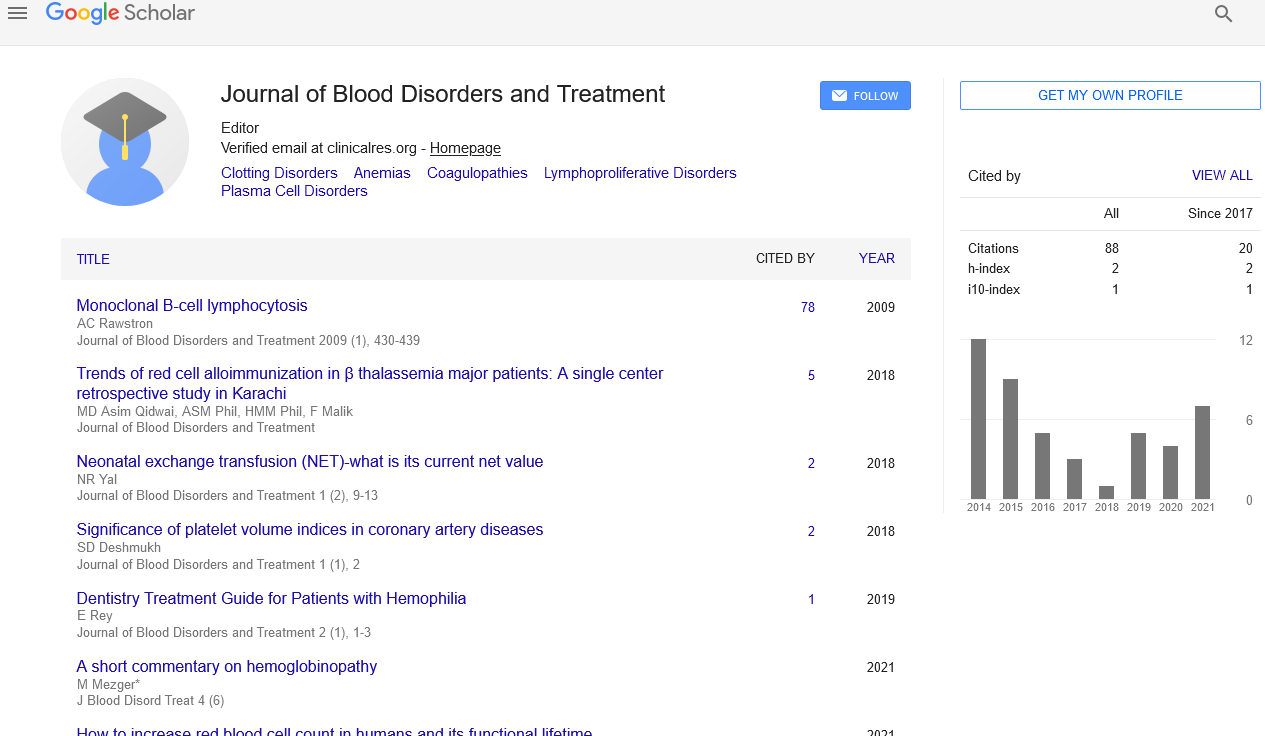Acute intermittent porphyria
Received: 04-Sep-2022, Manuscript No. puljbdt-23-6213; Editor assigned: 06-Sep-2022, Pre QC No. puljbdt-23-6213 (PQ); Accepted Date: Sep 20, 2022; Reviewed: 10-Sep-2022 QC No. puljbdt-23-6213 (Q); Revised: 12-Sep-2022, Manuscript No. puljbdt-23-6213 (R); Published: 30-Sep-2022, DOI: 10.37532/puljbdt.2022.5(5).03
Citation: Collins A. Acute intermittent porphyria. J. Blood Disord Treat. 2022;5(5):03
This open-access article is distributed under the terms of the Creative Commons Attribution Non-Commercial License (CC BY-NC) (http://creativecommons.org/licenses/by-nc/4.0/), which permits reuse, distribution and reproduction of the article, provided that the original work is properly cited and the reuse is restricted to noncommercial purposes. For commercial reuse, contact reprints@pulsus.com
Abstract
A rare autosomal dominant condition known as acute intermittent porphyria is marked by a lack of Hydroxymethylbilane Synthase (HMBS). It manifests as sickness, vomiting, seizures, peripheral neuropathy, and abdominal discomfort. Intravenous heme is used as a treatment for acute episodes. An ortho topic liver transplant is the only effective therapy.
Keywords
Porphyria ; Hydroxymethylbilane synthase
Introduction
An overview of the aetiology, clinical presentation, assessment, management, and treatment of the illness by an interprofessional team is provided in this exercise. The RARA gene creates a protein that aids in white blood cell maturation after the promyelocyte stage. The term "porphyria" is taken from the Greek word "porphura," which means purple. Heme, a crucial part of haemoglobin, is formed from porphyrins. Every haemoglobin subunit is a globular protein with an embedded heme group, which has one iron atom and can bond one oxygen molecule. Every stage of the multi-step heme synthesis pathway requires a different enzyme. Porphyrias are thus separate clinical syndromes that result from a lack of or a flaw in a specific enzyme required for a particular step of the heme synthesis pathway. Although these syndromes are typically categorised according to the dominant system involved, there is substantial overlap, and there are numerous porphyrias present
One of the four porphyrias, AIP, manifests as a sudden assault. 90% of those affected never have an acute incident and are asymptomatic, while 5% of those affected are thought to have repeat attacks. Attacks are uncommon before adolescence or after menopause and most frequent in young adult females. Hospitalization may be necessary for severe acute episodes. Symptoms are typically felt by patients during episodes that last a few hours to a few days. The patients are asymptomatic in between episodes. Genes that encode heme synthesis enzymes are mutated to produce porphyrias. Heme synthesis starts in the mitochondrion in typical physiology, moves into the cytoplasm, and ends back in the mitochondrion. All cells generate heme, but erythropoietic cells in the bone marrow and parenchymal cells in the liver, where hemoprotein turnover is high, produce 80% and 15% of all heme, respectively. On the long arm of chromosome 11, at the HMBS locus, which produces the cytoplasmic enzyme porphobilinogen deaminase, over 100 mutations have been linked to AIP. Since heme synthesis is prevented by this deficiency, it cannot be finished, and the metabolite porphobilinogen builds up in the cytoplasm.
AIP is an autosomal dominant porphyria that reduces the affected enzyme's usual activity by about 50%. With only 10% of gene carriers having acute attacks, the penetrance of AIP is insufficient, implying a potential role for other modifying genes or environmental factors. It is unclear what exactly causes acute episodes. The theory that an accumulation of porpholobilinogen has neurotoxic effects is the one that is most frequently accepted. Due to the absence of the blood-brain barrier, the autonomic and peripheral neural systems are more susceptible than the central nervous system. Tachycardia and abdominal discomfort, for example, are explained by this. Given that some people's synapses are more vulnerable to toxins, they may be more likely to experience paresis.
A partial lack of porphobilinogen deaminase causes the uncommon autosomal dominant inherited disorder known as Acute Intermittent Porphyria (AIP), which causes an accumulation of porphyrin precursors and porphyrins in the body. The majority of people are asymptomatic, but using certain medications, using steroid hormones, or changing one's nutritional state can cause symptoms to appear. Peripheral motor neuropathy, tachycardia, hypertension, discomfort in the chest, back, and limbs, nausea, and vomiting are among the most typical presenting symptoms. There is no inflammation present, and the discomfort is neuropathic. Significant rises in the urinary excretion of heme pathway intermediates lead to red or brownish urine. When exposed to long-wave ultraviolet light, porphyrins fluoresce and turn scarlet. Porphobilinogen is a colourless substance that breaks down into porphyrins and brownish pigments when left to remain.





